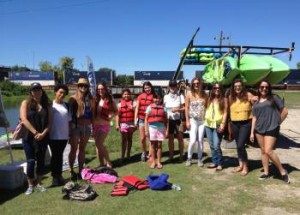Play. Play. Play. Have you ever seen a child who wanted to stop playing? Play is an important childhood activity and a natural part of a child’s life. Young children do not differentiate between play, work and learning. Children learn about the world around them through play. They enjoy playing and will do it whenever they can.
Do you remember playing as a young child? You may remember riding your bike, sliding down a hill, playing games or playing with your friends. Play is an integral part of children’s lives. Children love to play and they should – it is essential for their overall growth and development!
Play contributes to all areas of a child’s development: physical, cognitive (mental), social and emotional. Playing contributes to the physical development of children by giving them opportunities to explore, discover and master physical skills. Children practice large motor skills by running, jumping, swinging, riding bikes, and kicking balls. They practice fine motor development when drawing with markers or crayons, cutting scissors, or playing with playdough.
Play contributes to children’s cognitive growth and development. By playing children learn concepts, sort and classify information, build their vocabulary, probe for answers, problem-solve, and develop critical thinking skills. Play offers children opportunities to gain more information that sets the foundation for additional learning. For example, when playing with blocks a child may learn that two small blocks equals one large block. Block play can become the foundation for learning math skills and fractions as children get older, and is one example of the endless learning opportunities that exist through play.
Play is vital to a child’s social development. Children learn social skills as they relate to each other while playing. Play helps children learn to get along with others, to share, to take turns, to negotiate, and to compromise. While playing children also discover that not everyone behaves the same way and that some behaviors are not acceptable.
Finally, play contributes to the emotional development of children. Playing provides a way for children to express their feelings and to learn about the feelings of others. Play can help children reduce anxieties, fears and stress. When playing, children develop self-confidence and learn to control their emotional reactions and impulses.
Children at different ages will play differently. Very young children such as infants and toddlers tend to play alone in what is called solitary play. Near age three, children become very interested in pretend or imaginative play. Four-year-olds tend to be more aggressive in their play, while five-year-olds can separate the real world from imaginary play. The older children become, the more they are interested in playing with their friends and peers.
Children should have sufficient time and space for play every day. Children do not necessarily need many playthings – sometimes just their imagination is enough. Accept the playfulness in yourself and have fun with the children. Play is what childhood is all about!






